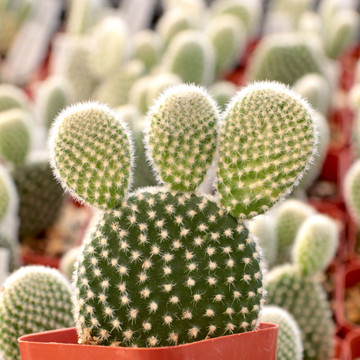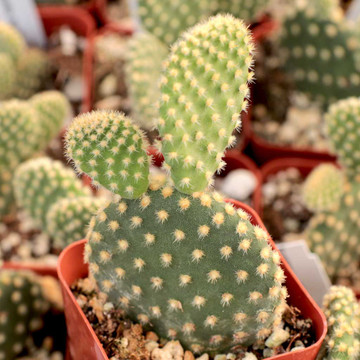Opuntia (oh-POON-tee-uh) (Prickly Pear Cactus) are known for their paddle-like leaves and large, showy flowers. They are easy to grow and maintain. Many can even thrive outdoors in regions too cold and wet for other cacti. Their quirky, sculptural appearance make for eye-catching silhouettes in the garden. Click here for a visual guide to planting Opuntia cactus pads.
APPEARANCE
- Form: Opuntia have pancake-like stems called "pads" that are about ¾" thick and 4"-16" long, with colors ranging from green to magenta. Varieties can grow 1'-6' tall and 3'-6' wide as they branch to form clumping mounds or robust shrubs. Every order consists of a 5"-7" cured, unrooted cactus pad.
- Spines: Varieties differ in the size and quantity of their spines (some are nearly spineless), but all have barbed glochid tufts. The glochids are small, but they can pierce leather gloves and lodge painfully in skin, so always use tongs for handling.
- Flowers: In the spring, Opuntia will show 1.5"-3" flowers of white, yellow, pink, or red, sometimes with different colored blooms on a single plant!
CARE
- Light: It is very important for Opuntia to get full sun for 6-12 hours per day. They can survive indoors by a sunny window if they get cool enough in the winter to go dormant.
- Soil: Opuntia need an air gap between their roots and the soil to grow, so a well-draining soil of 50% sand is crucial. Heavy clay and organic soils will stay too wet, inhibit growth, and eventually cause root rot. Plants in containers may be re-potted in spring to allow space for new air pockets into which the roots can expand.
- Water: Deeply drench in the evening and wait for the soil to dry thoroughly before watering again. Frequency will depend on species, soil type, and location, so it is key to regularly observe your plants and the soil to gauge moisture content. To start, aim to water every 1-2 weeks in the spring and summer, 1-2 times per month in the fall and winter, and not at all if the temperature drops below freezing. Young, recently planted pads will need slightly more frequent watering until they establish roots.
- Hardiness: Many varieties of Opuntia are frost hardy down to at least -10F (zone 6) and they overwinter well with a layer of mulch for insulation. Pads often turn purple and wrinkle in winter as they reduce water content to survive freezing temperatures. Opuntia still need plenty of sunlight in winter and potted plants can be moved indoors or to a covered area to prevent standing water. Our potted, 2" Opuntia are not frost hardy but grow well indoors on a sunny sill.
- Propagation: Cut a full pad from a mature cactus and let the cut dry and callus for 7-10 days. Follow this link for a visual guide to planting the cut pad.
NOTES FROM THE NURSERY
Growing Opuntia is an easy, hands-off process when planted in the right location. Good companion plants include Aloe, Agave, and Echeveria.
"[Opuntia] add a unique charm and a definite Southwest desert feel to a garden" (Leo J. Chance, Cacti & Succulents for Cold Hardy Climates).
READ MORE





